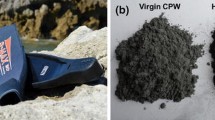Abstract
The research object is a cement-based heat-insulating material with wood waste. The preparation of wood-cement mixtures was carried out using the selected technological parameters by dispersing in a vibro-rotary mill of periodic action. The aim of the study is to establish the dependence of the physical and technical properties (a thermal conductivity coefficient, compressive strength and density) of cement heat-insulating material on the ratio of the components of mixtures with sawdust.
The research was carried out by the method of experiment planning, taking into account the interpolation capabilities of the models. Based on the results of the experiment, mathematical models were constructed and graphs of the dependence of the thermal conductivity coefficient and compressive strength on the sawdust/cement and water/cement ratios were presented with constant sand/cement and lime/cement ratios. It was found that with an increase in the content of sawdust in the mixture (sawdust/cement ratio is in the range from 0.25 to 0.75), the strength of the samples significantly decreases (up to 64%), and the coefficient of thermal conductivity decreases on average by 15%. Compositions of mixtures with given values of the thermal conductivity coefficient have been selected, having compressive strength indicators in the range from 0.4 to 1.1 MPa, which make it possible to obtain heat-insulating wood-cement materials. Possible areas of application of these cement heat-insulating materials with the use of wood waste have been determined: insulation of floor of the ground floor, wall and partition blocks.
Access this chapter
Tax calculation will be finalised at checkout
Purchases are for personal use only
Similar content being viewed by others
References
Kolesnikova AV (2013) Analiz obrazovaniya i ispol’zovaniya drevesnyh othodov na predpriyatiyah lesopromyshlennogo kompleksa Rossii [Analysis of the formation and use of wood waste at the enterprises of the Russian timber industry complex]. Aktual’nye voprosy ekonomicheskih nauk [Topical issues of economic sciences], no 33, pp 116–120. (rus). https://www.elibrary.ru/download/elibrary_20722278_22216470.pdf. Accessed 18 Nov 2021
Borzunova AG, Zinov’eva IS (2012) Kompleksnaya pererabotka drevesnogo syr’ya. Utilizaciya drevesnyh othodov [Complex processing of wood raw materials. Utilization of wood waste]. Uspekhi sovremennogo estestvoznaniya [Advances in modern natural science], no 4, pp. 180–181. (rus). https://natural-sciences.ru/ru/article/view?id=29983. Accessed 18 Nov 2021
Shevchenko VA, Lebedeva TG, Kiselev VP, Chuprova NA, Ivanova LA, Terekhova II (2018) Issledovanie svojstv vtorichnogo drevesnogo zapolnitelya dlya arbolita [Study of the properties of recycled wood filler for wood concrete]. Sovremennye naukoemkie tekhnologii [Modern high technologies], no 3, pp 112–116. (rus). https://top-technologies.ru/ru/article/view?id=36946. Accessed 18 Nov 2021
Gornostaeva EYU, Lasman IA, Fedorenko EA, Kamoza EV (2015) Drevesno-cementnye kompozicii s modificirovannoj strukturoj na makro-, mikro- i nanourovnyah [Wood-cement compositions with structures modified at macro-, micro- and nano- levels]. Stroitel’nye materialy [Construction Materials], no 11, pp 13–17. (rus). https://journal-cm.ru/images/files/2015/2015_11_013-016.pdf. Accessed 18 Nov 2021
Leonovich AA, Vojtova TN (2014) Povyshenie ekologicheskoj bezopasnosti drevesno-struzhechnyh plit [Improvement of the environmental safety of wood particle boards]. Izvestiya vysshih uchebnyh zavedenij. Lesnoj zhurnal [Russian Forestry Journal], no 6, pp 120–129. (rus). https://www.elibrary.ru/download/elibrary_22595409_22592751.pdf. Accessed 18 Nov 2021
Zaprudnov VI, Karpachyov SP (2017) Tekhnologiya izgotovleniya trekhslojnyh monolitnyh konstrukcij s teploizolyacionnym sloem iz drevesno-cementnogo materiala [Manufacturing technology of three-layer monolithic structures with a heat-insulating layer of wood-cement material]. Lesnoj vestnik [Forestry Bulletin], vol 21, no 5, pp 83–88. (rus). https://doi.org/10.18698/2542-1468-2017-5-83-88
Polishchuk AI, Rubinskaya AV (2012) Himicheskaya agressivnost’ zapolnitelya rastitel’nogo proiskhozhdeniya po otnosheniyu k cementu [Chemical aggressiveness of the filler of plant origin in relation to cement]. Aktual’nye problemy lesnogo kompleksa, Bryansk, “Bryanskaya gosudarstvennaya inzhenerno-tekhnologicheskaya akademiya” [Actual problems of the forestry complex, Bryansk, “Bryansk State Engineering and Technological Academy”], no 34, pp 72–74. (rus). https://www.elibrary.ru/download/elibrary_21979272_46052682.pdf. Accessed 18 Nov 2021
Shitova IYU, Samoshina EN, Kislicyna SN, Boltyshev SA (2015) Sovremennye kompozicionnye stroitel’nye materialy, Penza, “Penzenskij gosudarstvennyj universitet arhitektury i stroitel’stva” [Modern composite building materials, Penza, “Penza State University of Architecture and Construction”], p 136. (rus)
Rudenko BD, Plotnikov SM (2012) Formirovanie struktury cementno-drevesnogo kompozita pri obrabotke izvest’yu drevesnogo zapolnitelya [Formation of structure of cement-wood composite the limingwoodfiller]. Aktual’nye problemy lesnogo kompleksa, Bryansk, “Bryanskaya gosudarstvennaya inzhenerno-tekhnologicheskaya akademiya” [Actual problems of the forestry complex, Bryansk, “Bryansk State Engineering and Technological Academy”], no 34, pp 82–84. (rus). https://www.elibrary.ru/download/elibrary_22573951_41321694.pdf. Accessed 18 Nov 2021
Mironov VA (2004) Razrabotka tekhnologicheskih variantov polucheniya stroitel’nyh materialov na osnove othodov derevoobrabotki [Development of technological options for obtaining building materials based on woodworking waste]. Zapiski Gornogo instituta, Sankt-Peterburg, “Sankt-Peterburgskij gornyj universitet” [Notes of the Mining Institute, St. Petersburg, “St. Petersburg Mining University”], vol 158, pp 245–247. (rus)
Titova SA, Vasil’ev SB (2016) Vliyanie razmera drevesnyh chastic zapolnitelya na teploprovodnost’ drevesno-cementnogo kompozita [The influence of aggregate wooden particles size on thermal conductivity of wood composite with cement binder]. Fundamental’nye issledovaniya [Fundamental research], no 5–1, pp 53–57. (rus). https://fundamental-research.ru/ru/article/view?id=40249. Accessed 18 Nov 2021
Nanazashvili IH (1990) Stroitel’nye materialy iz drevesno-cementnoj kompozicii [Building materials made of wood-cement composition]. Strojizdat, p 415. (rus)
Dvorkin LI, Dvorkin OL (1999) Proektirovanie sostavov betonov s zadannymi svojstvami [Design of concrete compositions with specified properties]. Rovno: Izd-vo RGTU, p 197. (rus)
Krasovskij GI, Filaretov GF (1982) Planirovanie ehksperimenta [Experiment planning], Izd-vo BGU. Minsk, p 302. (rus)
Zaprudnov VI, Sanaev, VG (2012) Makroskopicheskie svojstva drevesno-cementnyh kompozitov [Macroscopic properties of wood-cement composites]. Vestnik Moskovskogo gosudarstvennogo universiteta lesa–Lesnoj vestnik [Moscow State Forest University Bulletin – Forestry Bulletin], no 6 (89), pp 168–171. (rus). https://www.elibrary.ru/download/elibrary_18485022_53707406.pdf. Accessed 18 Nov 2021
Author information
Authors and Affiliations
Corresponding author
Editor information
Editors and Affiliations
Rights and permissions
Copyright information
© 2023 The Author(s), under exclusive license to Springer Nature Switzerland AG
About this paper
Cite this paper
Kuznetsova, N.V., Seleznev, A.D. (2023). Component Compositions of Mixtures of Cement-Wood Heat-Insulating Material. In: Vatin, N., Pakhomova, E.G., Kukaras, D. (eds) Modern Problems in Construction. Lecture Notes in Civil Engineering, vol 287. Springer, Cham. https://doi.org/10.1007/978-3-031-12703-8_11
Download citation
DOI: https://doi.org/10.1007/978-3-031-12703-8_11
Published:
Publisher Name: Springer, Cham
Print ISBN: 978-3-031-12702-1
Online ISBN: 978-3-031-12703-8
eBook Packages: EngineeringEngineering (R0)




